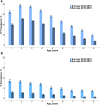Twelve-Year Longitudinal Trends in Trachoma Prevalence among Children Aged 1-9 Years in Amhara, Ethiopia, 2007-2019
- PMID: 33534757
- PMCID: PMC8045658
- DOI: 10.4269/ajtmh.20-1365
Twelve-Year Longitudinal Trends in Trachoma Prevalence among Children Aged 1-9 Years in Amhara, Ethiopia, 2007-2019
Abstract
Trachoma control in the Amhara region of Ethiopia, where all districts were once endemic, began in 2001 and attained full scale-up of the Surgery, Antibiotics, Facial cleanliness, and Environmental improvement (SAFE) strategy by 2010. Since scaling up, the program has distributed approximately 14 million doses of antibiotic per year, implemented village- and school-based health education, and promoted latrine construction. This report aims to provide an update on the prevalence of trachoma among children aged 1-9 years as of the most recent impact or surveillance survey in all 160 districts of Amhara. As of 2019, 45 (28%) districts had a trachomatous inflammation-follicular (TF) prevalence below the 5% elimination threshold. There was a statistically significant relationship between TF prevalence observed at the first impact survey (2010-2015) and eventual achievement of TF < 5% (2015-2019). Of the 26 districts with a first impact survey < 10% TF, 20 (76.9%) had < 5% TF at the most recent survey. Of the 75 districts with a first survey between 10% and 29.9% TF, 21 (28.0%) had < 5% TF at the most recent survey. Finally, among 59 districts ≥ 30% TF at the first survey, four (6.8%) had < 5% TF by 2019. As of 2019, 30 (18.8%) districts remained with TF ≥ 30%. Amhara has seen considerable reductions of trachoma since the start of the program. A strong commitment to the SAFE strategy coupled with data-driven enhancements to that strategy is necessary to facilitate timely elimination of trachoma as a public health problem regionally in Amhara and nationwide in Ethiopia.
Figures







References
-
- WHO , 2019. WHO alliance for the global elimination of trachoma by 2020: progress report on elimination of trachoma, 2018. Weekly Epidemiological Rec 94: 317–328.
-
- WHO , 1998. WHA51.11 Global Elimination of Blinding Trachoma. Geneva, Switzerland: World Health Organization. Available at: http://www.who.int/neglected_diseases/mediacentre/WHA_51.11_Eng.pdf. Accessed September 15, 2020.
-
- Cerulli LCC, Culasso F, Martelli M, Tria M, 1981. Epidemiolgoical study of trachoma in two regions of Ethiopia. Rev Int Trach Path 68: 147–155. - PubMed
-
- Okubagzhi G, 1997. Epidemiology of trachoma in north-western Ethiopia. East Afr Med J 64: 611–616. - PubMed
-
- Assefa TAD, Foster A, Schwrtz E, 2001. Results of trachoma rapid assessment in 11 villages of south Gondar zone, Ethiopia. Trop Doctor 31: 202–204. - PubMed
Publication types
MeSH terms
Substances
LinkOut - more resources
Full Text Sources
Other Literature Sources
Research Materials
Miscellaneous

